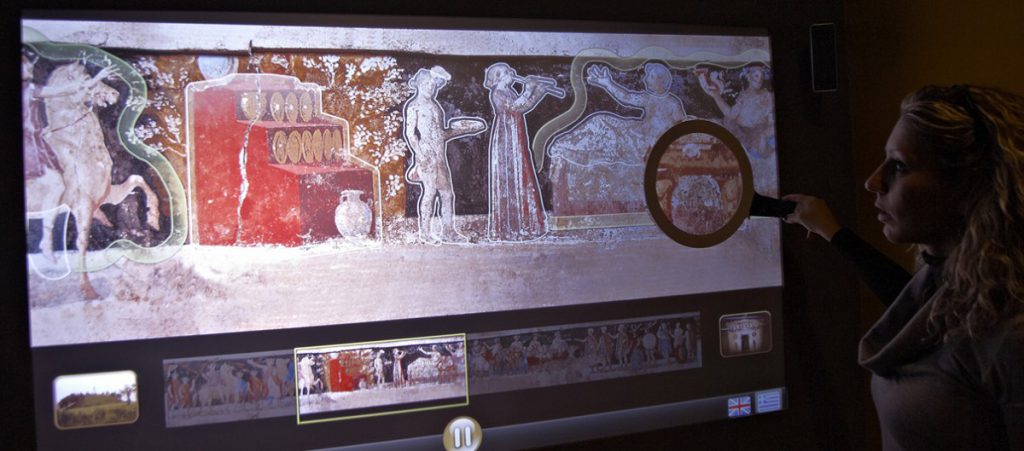“Macedonia: From fragments to pixels” is an exhibition of seven (7) innovative interactive systems developed in the laboratories of the Foundation for Research & Technology – Hellas (FORTH), Institute of Computer Science. These applications project artefacts from the rich collections of the A.M.Th. as well as other sites and museums in Macedonia. Two of these applications were incorporated into the Museum’s permanent exhibitions, while the remaining five are located at a specially-designed hall on the Museum’s ground floor.
This exhibition differs from a conventional one, as the new technologies employed allow visitors to access unique artefacts, archaeological sites and monuments, offering a new interactive experience that combines information and learning through playing. Hence, visitors can explore digital representations of ancient artefacts, travel in time and space and discover, in a simple and modern way, aspects of the history and archaeology of ancient Macedonia, through its virtual image.
- PaperView is a tabletop augmented reality system that supports the exploration of terrain-based information (e.g., areas of interest on a 2D map, or a 3D scale model) using rectangular pieces of plain cardboard. The system allows users to study information and interactive multimedia, using the cardboards as individual interactive screens; these cardboard screens can be lifted and held at various angles. Multiple users can concurrently use the table. Paper View illustrates the most important ancient areas on the map of Macedonia, including cities, settlements and cemeteries.
- Macrographia is a system that presents a fresco depicting a royal hunt wall-painting, from the tomp of Philip II, father of Alexander the Great, founded in Vergina. Visitors are able to explore different levels of information walking across a large projection area. The fresco is analysed part-by-part depending on the location of each visitor in the room. Visitors enter the room and the system follows the movement of each one separately. When a user stands in front of a section of the image, as approching closer to the wall, he recieves more detailed layers of information combined with a better reconstruction of the fresco more similar to the very first painting back in 336 BC. Visitors can select the language of the accompanying text by entering the room from the left or right side.
- Cryptolexo consists of a multitouch screen which can be used by one or more players. The names of gods and heroes are hidden within a grid of random letters. As the words are successfully selected, multimedia content with descriptive text, concerning artifacts from the Greek mythodology, is provided on the screen.
- Panoptes is a digital exhibition-catalogue system which allows visitors to browse its content and dwell on details of images, read accompanying texts and follow threads of information. Panoptes builds upon the concepts of playful and aesthetic interaction combining functionality with playfulness and serendipity, thus offering an alternative to information kiosks used for browsing item collections. The user is able to discover the gold Macedonian wreaths from the collection of the Archaeological Museum of Thessaloniki by blowing on the windmill toy accompanying the system.
- Polyapto comprises a very large interactive screen that can be used by several visitors who wish to explore multifaceted information on a subject at the same time. The system presents a Macedonian fresco depicting a symposium.
- Peridexio is a system that offers users the possibility of exploring an object in depth. The system has a touch screen that presents a view of an object at a time. Visitors can select the object or the view they wish to see and then discover points of interest and relative multimedia information, or zoom in on any detail at will.
